The Influence of Sandstorms and Long-Range Transport on Polycyclic Aromatic Hydrocarbons (PAHs) in PM2.5 in the High-Altitude Atmosphere of Southern China
Abstract
:1. Introduction
2. Materials and Methods
2.1. Sampling
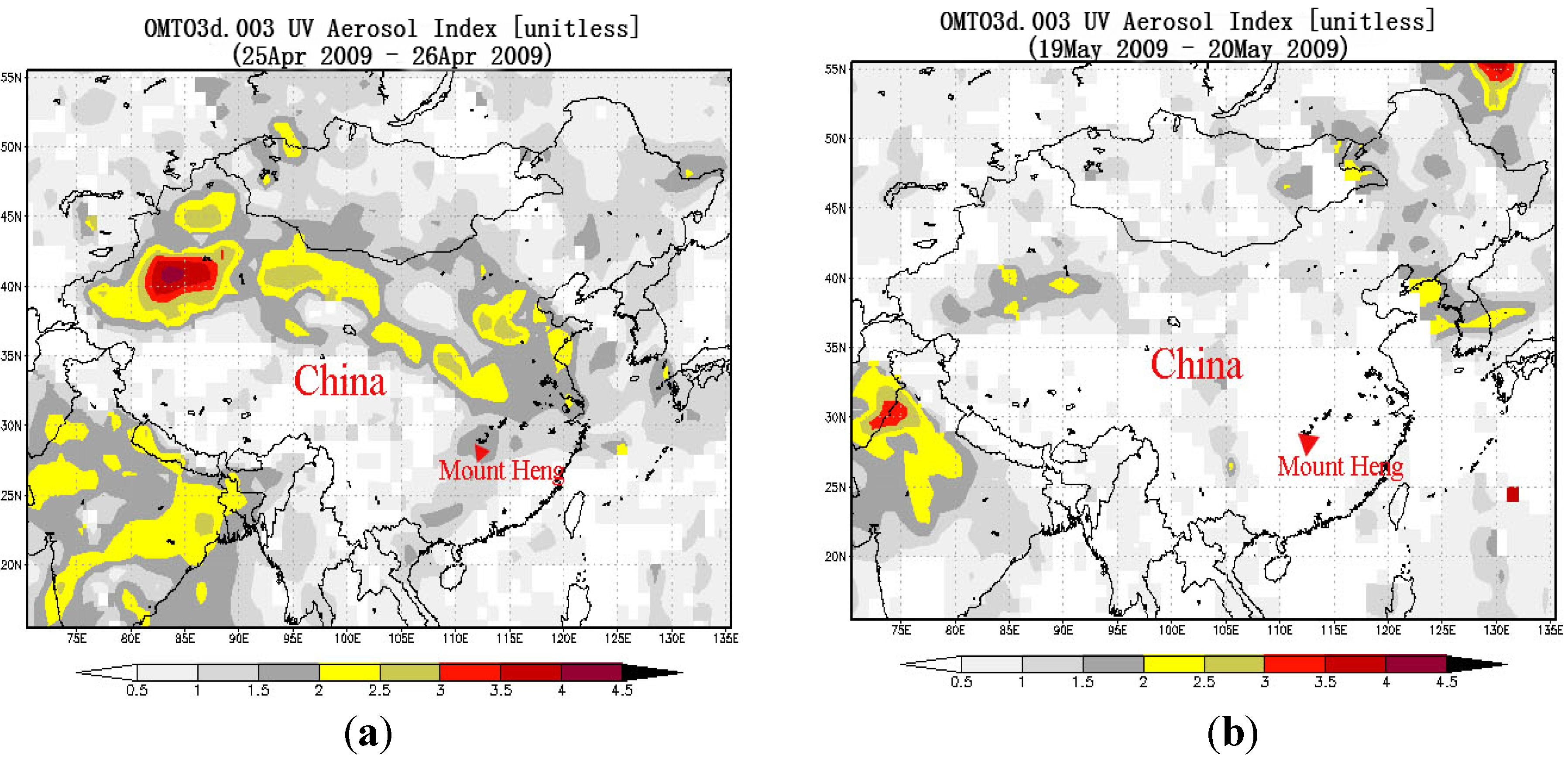
2.2. Analytical Techniques
2.3. Quality Assurance and Control
2.4. Modeling Tools and Methodology
3. Results and Discussion
3.1. PM2.5 and PAH Concentrations and Distributions at Mount Heng

| PAH | Sandstorm | No Sandstorm | ||||||
|---|---|---|---|---|---|---|---|---|
| Max | Min | Average | Stdev | Max | Min | Average | Stdev | |
| Ace | 1.9 | 1.14 | 1.52 | 0.3 | 2.39 | 0.3 | 1.14 | 0.58 |
| Acy | 6.46 | 2.18 | 3.99 | 1.49 | 34.91 | 1.32 | 5.2 | 5.65 |
| Flu | 4.82 | 1.49 | 2.72 | 1.26 | 30.04 | 0.67 | 4.58 | 4.81 |
| PhA | 9.85 | 3.42 | 5.35 | 2.33 | 31.69 | 1.52 | 9.59 | 6.46 |
| AnT | 3.16 | 0.82 | 2.05 | 1 | 8.12 | 0.82 | 2.24 | 1.48 |
| FluA | 5.87 | 1.68 | 3.54 | 1.47 | 71.21 | ND | 9.74 | 14.44 |
| Pyr | 5.06 | 1.22 | 2.65 | 1.35 | 61.91 | ND | 8.17 | 11.85 |
| BaA | ND | ND | ND | ND | 31.08 | ND | 3.48 | 6.95 |
| Chr | ND | ND | ND | ND | 57.07 | ND | 5.42 | 10.34 |
| BbF | 3.6 | ND | 1.19 | 1.84 | 82.76 | ND | 9.14 | 15.66 |
| BkF | 3.14 | ND | 0.79 | 1.32 | 22.67 | ND | 4.64 | 5.21 |
| BaP | 3.89 | ND | 1.21 | 1.88 | 27.6 | ND | 4.76 | 6.21 |
| InP | 2.47 | ND | 0.68 | 1.09 | 37.65 | ND | 4.71 | 7.55 |
| DbA | ND | ND | ND | ND | 12.96 | ND | 1.06 | 2.3 |
| BP | 6.6 | 3.7 | 5.02 | 0.99 | 54.01 | ND | 6.92 | 10.2 |
| SUM | 56.83 | 15.64 | 30.7 | 16.31 | 566.08 | 4.63 | 80.8 | 109.7 |
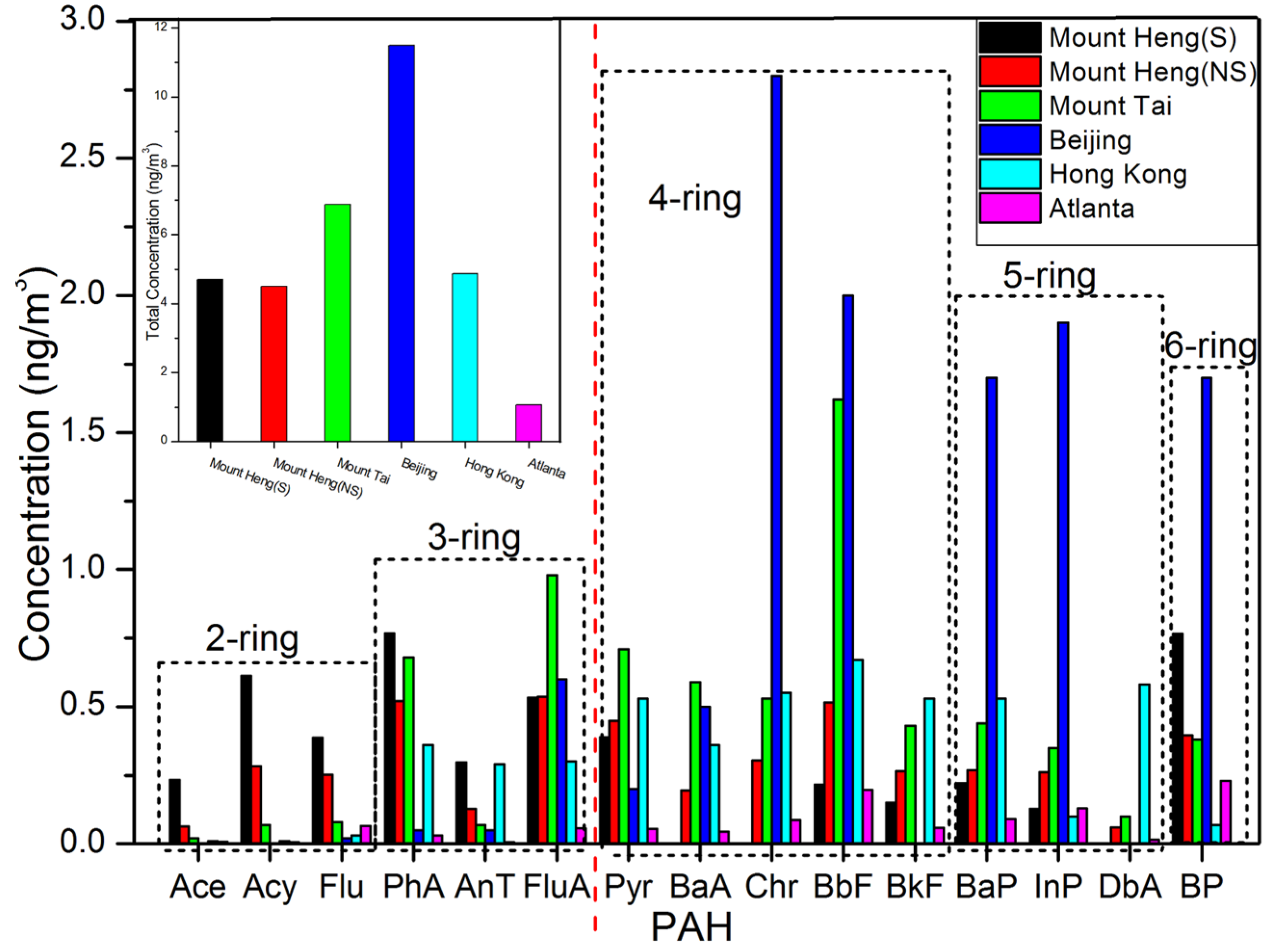
3.2. Diagnostic Ratio Analysis of PAHs
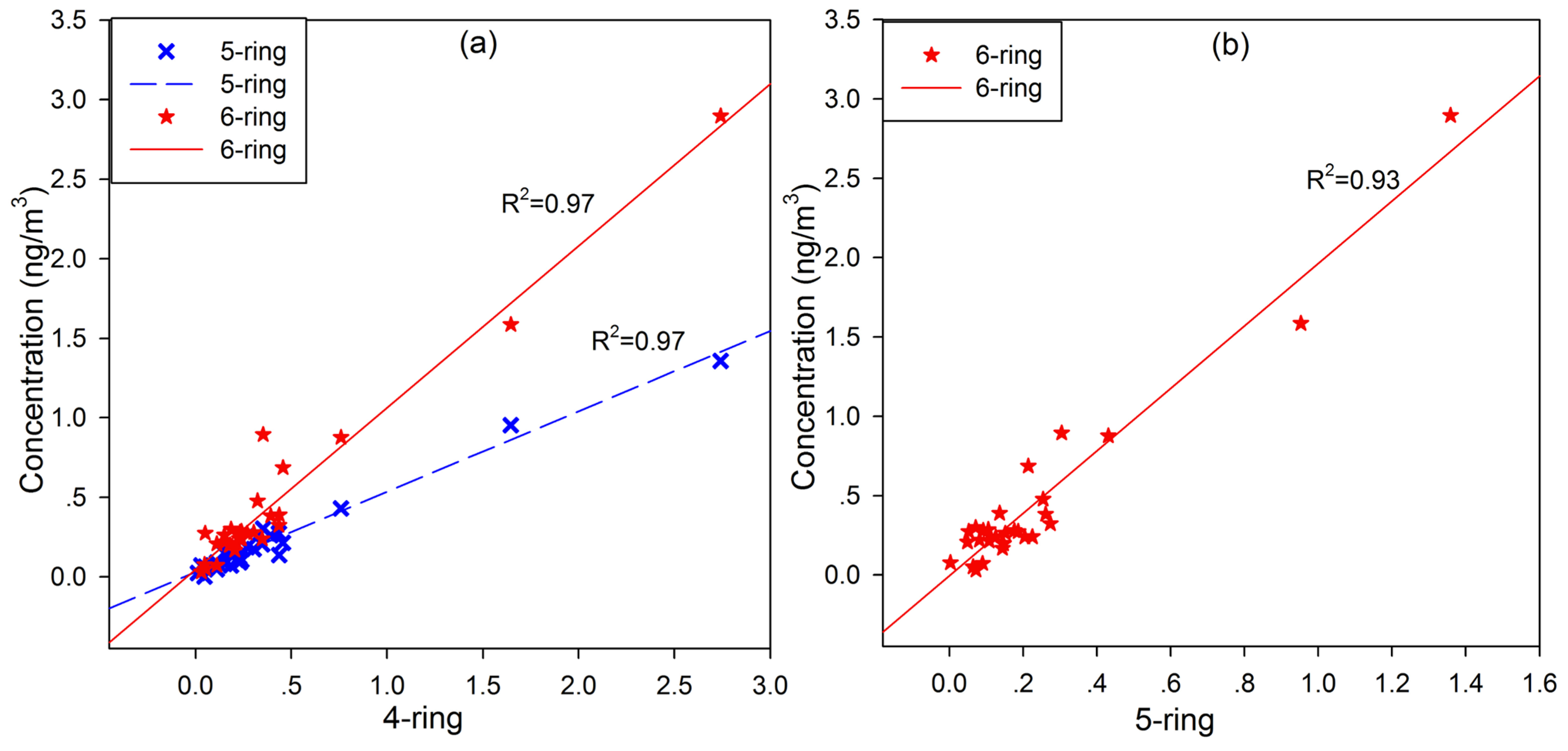
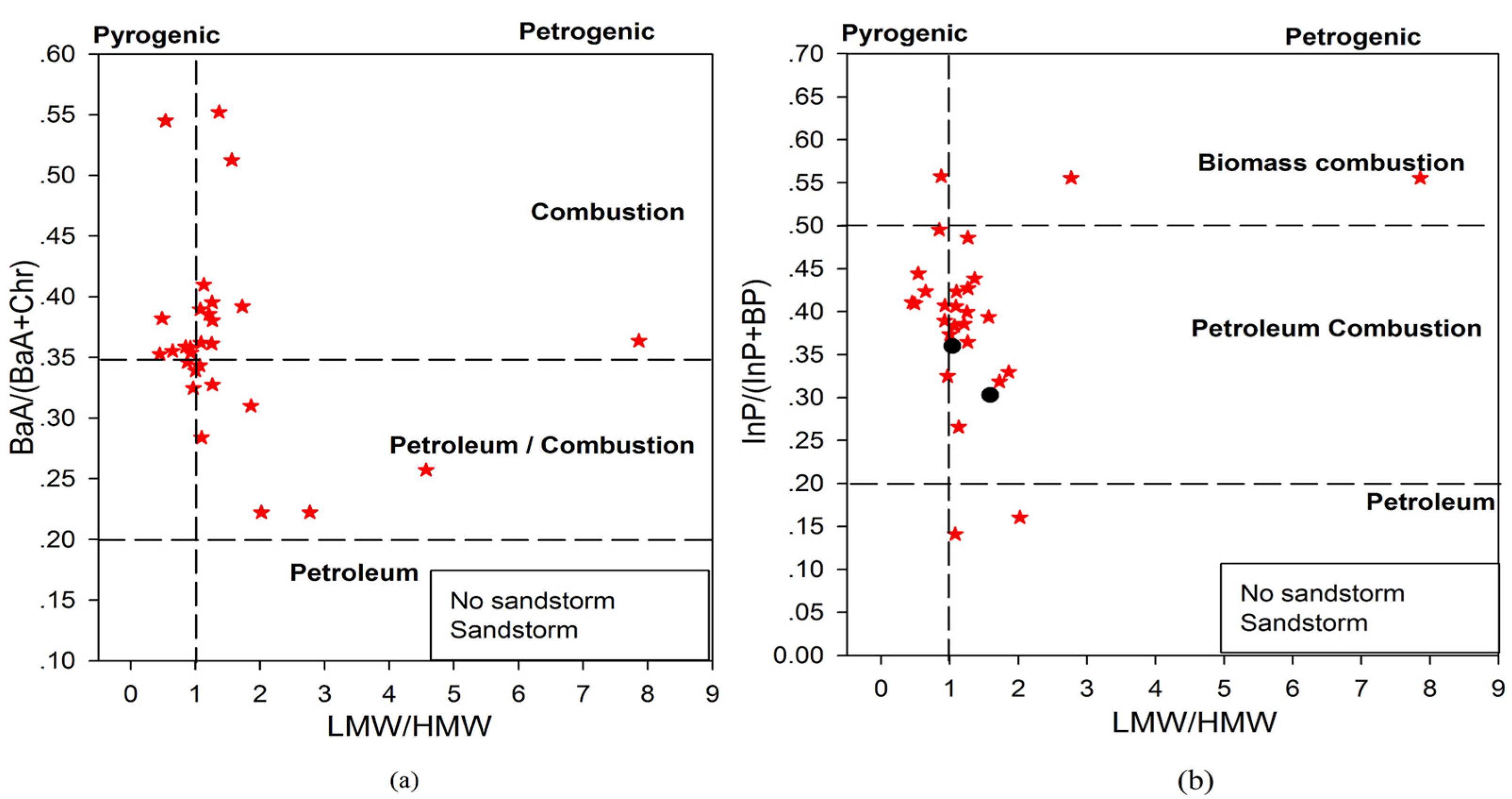
3.3. Implications of Long-Range Transport for Air Pollution

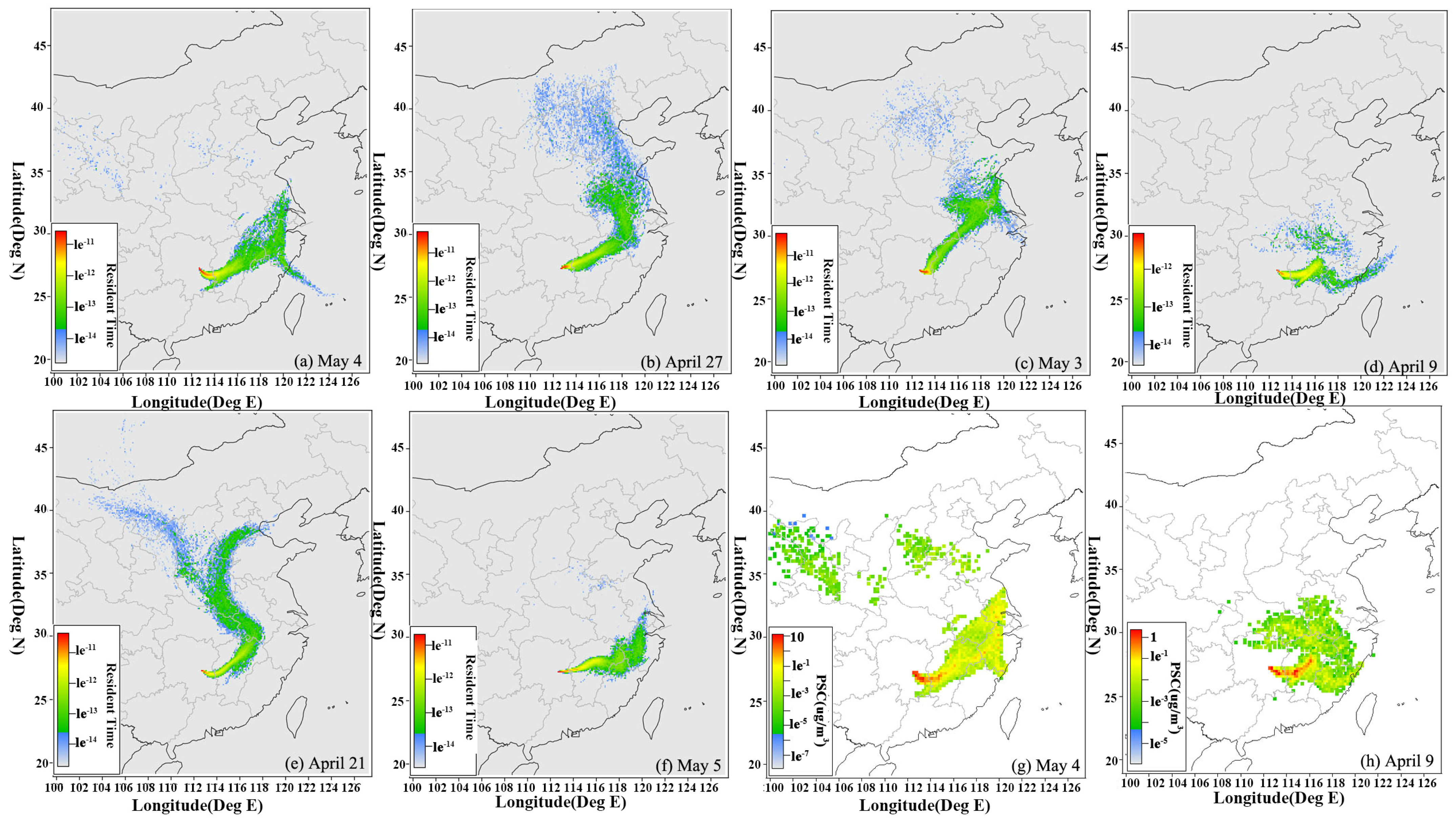
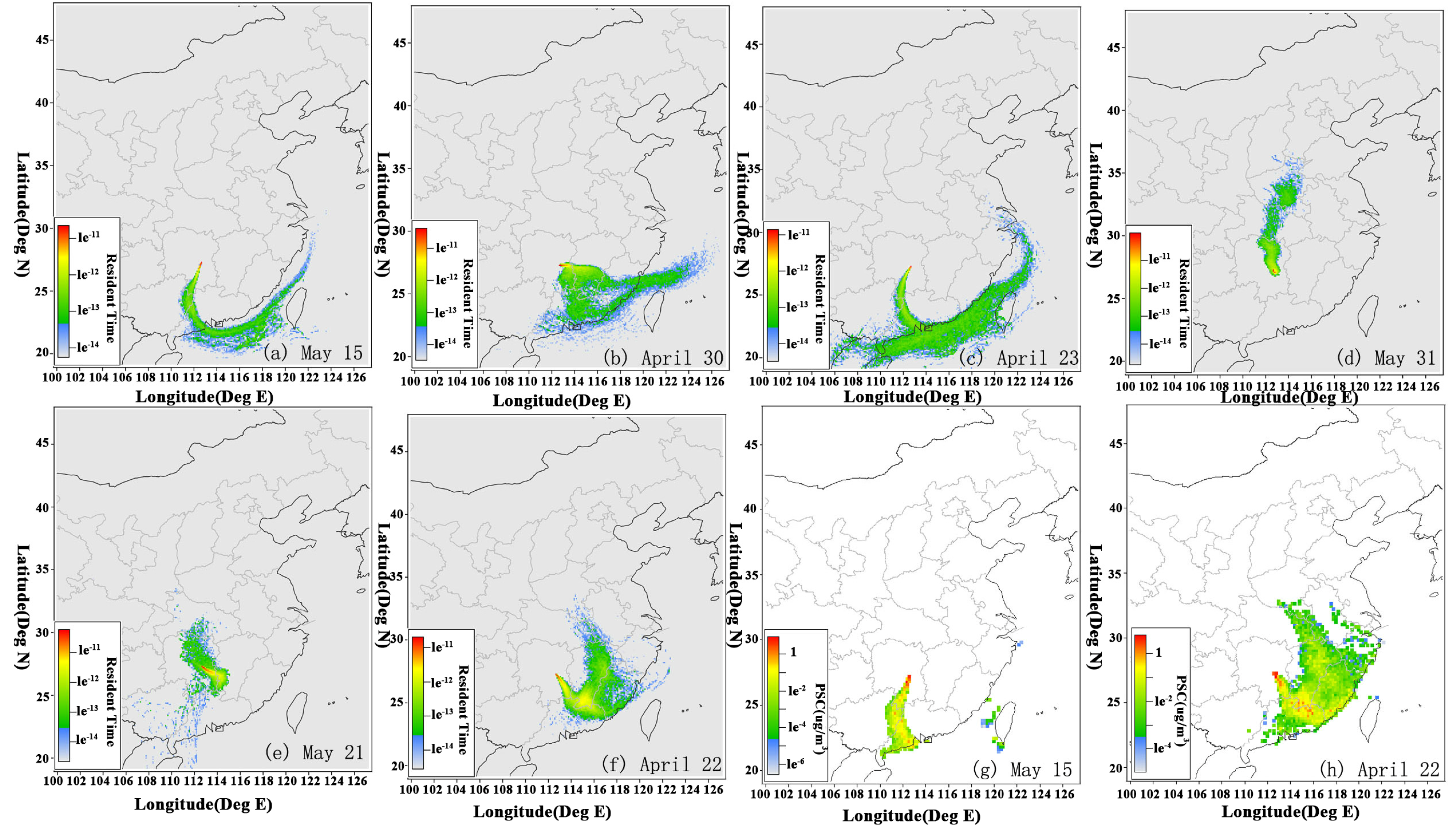
4. Conclusions
Acknowledgments
Author Contributions
Conflicts of Interest
Appendix
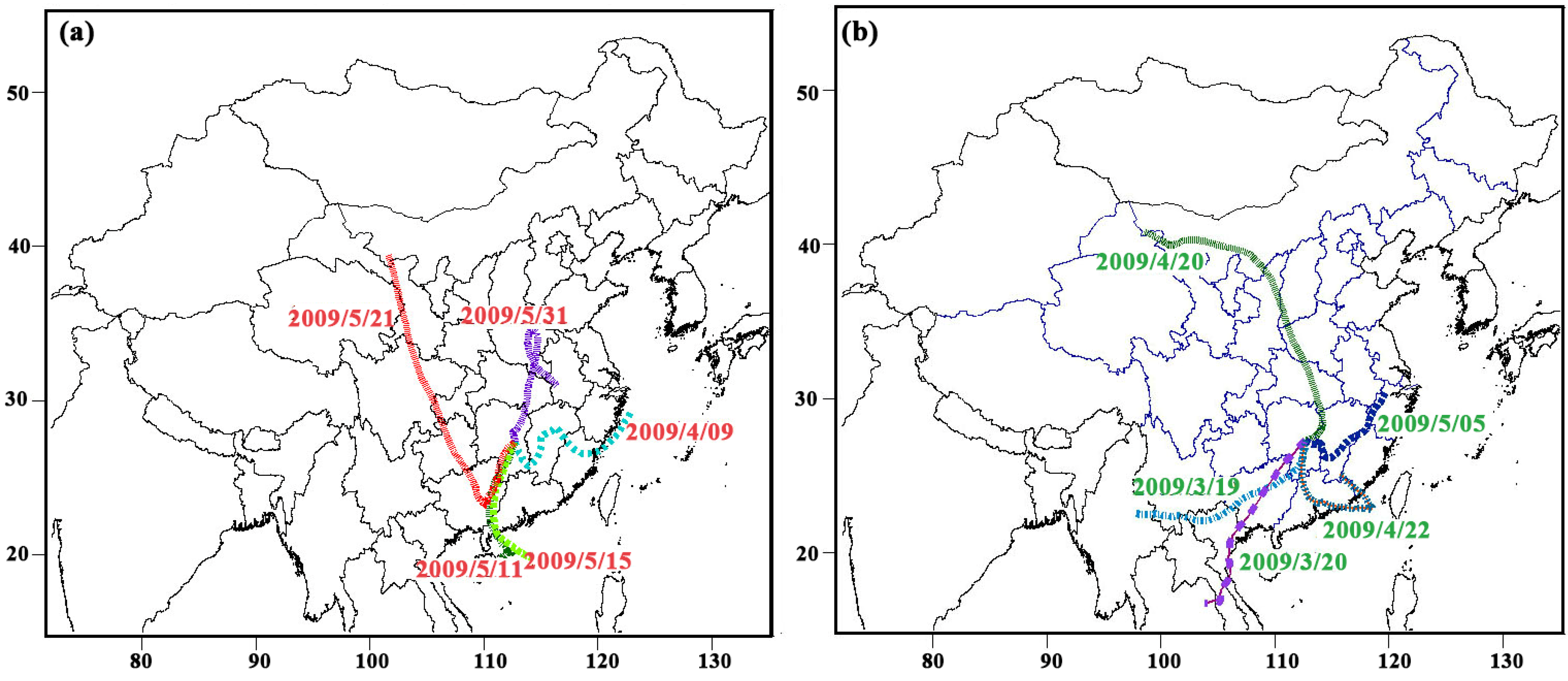
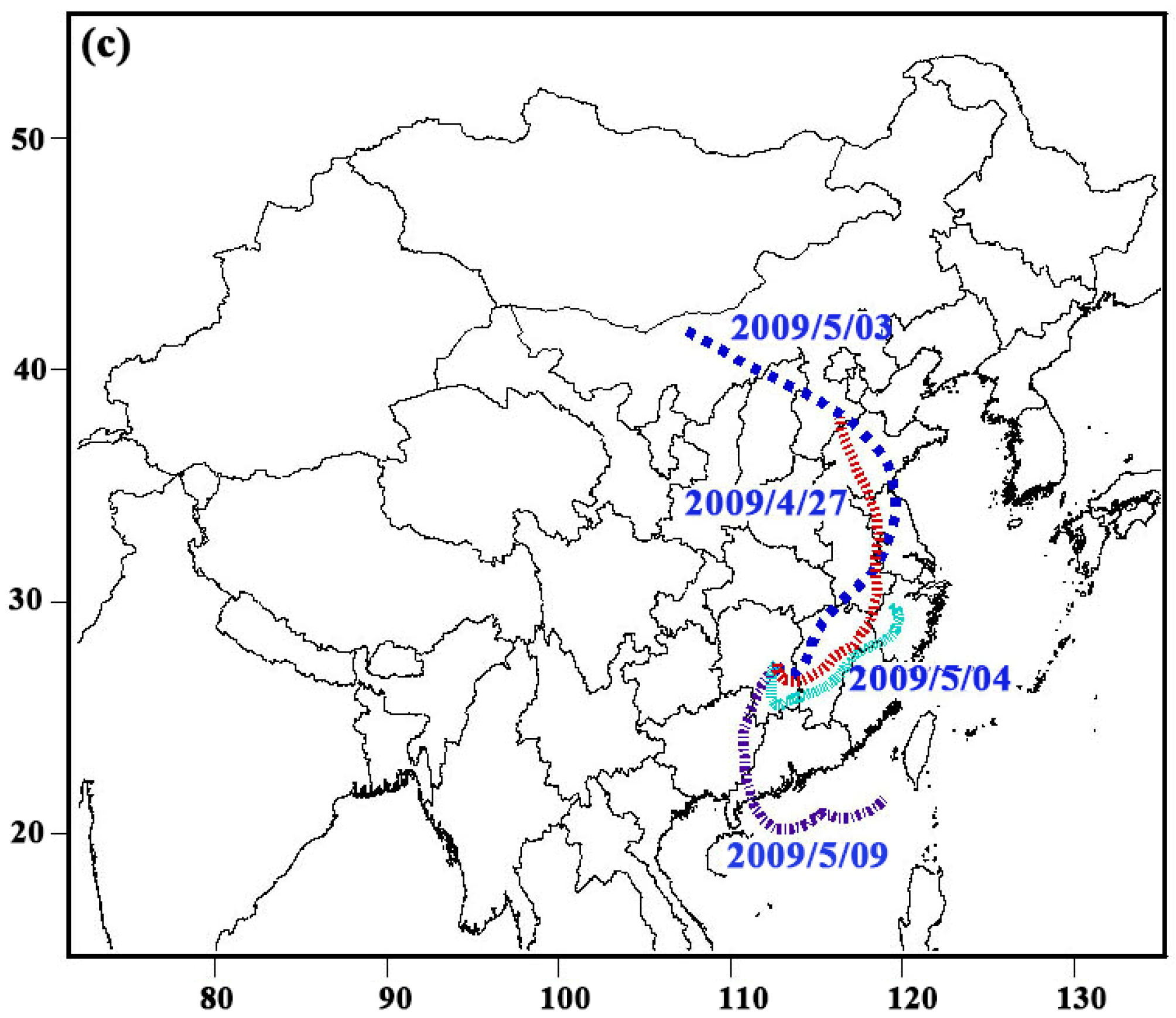
References
- Wang, Y.; Hopke, P.K.; Xia, X.; Rattigan, O.V.; Chalupa, D.C.; Utell, J.E. Source apportionment of airborne particulate matter using inorganic and organic species as tracers. Atmos. Environ. 2012, 55, 525–532. [Google Scholar] [CrossRef]
- Pui, D.Y.H.; Chen, S.-C.; Zuo, Z. PM2.5 in China: Measurements, sources, visibility and health effects and mitigation. Particuology 2013, 13, 1–26. [Google Scholar] [CrossRef]
- Li, Z.; Porter, E.N.; Sjödin, A.; Needham, L.L.; Lee, S.; Russell, A.G.; Mulholland, J.A. Characterization of PM2.5 bound polycyclic aromatic hydrocarbons in Atlanta—Seasonal variations at urban, suburban, and rural ambient air monitoring sites. Atmos. Environ. 2009, 43, 4187–4193. [Google Scholar] [CrossRef]
- Neff, J. Polycyclic aromatic hydrocarbons in the aquatic environment and cancer risk to aquatic organisms and man. Am. Environ. Prot. Agency Rep. 1982, 600, 9–82. [Google Scholar]
- Bopp, S.K.; Lettieri, T. Gene regulation in the marine diatom thalassiosira pseudonana upon exposure to polycyclic aromatic hydrocarbons (PAHs). Gene 2007, 396, 293–302. [Google Scholar] [CrossRef] [PubMed]
- Wilhelm, M.; Ghosh, J.K.; Su, J.; Cockburn, M.; Jerrett, M.; Ritz, B. Traffic-related air toxics and preterm birth: A population-based case-control study in Los Angeles County, California. Environ. Health 2011, 10, 89–89. [Google Scholar] [CrossRef] [PubMed]
- Straif, K.; Baan, R.; Grosse, Y.; Secretan, B.; El Ghissassi, F.; Cogliano, V. Carcinogenicity of household solid fuel combustion and of high-temperature frying. Lancet Oncol. 2006, 7, 977–978. [Google Scholar] [CrossRef]
- Yunker, M.B.; Macdonald, R.W.; Vingarzan, R.; Mitchell, R.H.; Goyette, D.; Sylvestre, S.; Mitchelld, D. PAHs in the Fraser River basin: A critical appraisal of PAH ratios as indicators of PAH source and composition. Org. Geochem. 2002, 33, 489–515. [Google Scholar] [CrossRef]
- Zakaria, M.P.; Takada, H.; Tsutsumi, S.; Ohno, K.; Yamada, J.; Kouno, E.; Kumata, H. Distribution of polycyclic aromatic hydrocarbons (PAHs) in rivers and estuaries in Malaysia: A widespread input of petrogenic PAHs. Environ. Sci. Technol. 2002, 36, 1907–1918. [Google Scholar] [CrossRef] [PubMed]
- Zhang, Y.; Tao, S. Global atmospheric emission inventory of polycyclic aromatic hydrocarbons (PAHs) for 2004. Atmos. Environ. 2009, 43, 812–819. [Google Scholar] [CrossRef]
- Chang, K.-F.; Fang, G.-C.; Chen, J.-C.; Wu, Y.-S. Atmospheric polycyclic aromatic hydrocarbons (PAHs) in Asia: A review from 1999 to 2004. Environ. Pollut. 2006, 142, 388–396. [Google Scholar] [CrossRef] [PubMed]
- Wang, Y.; Li, P.H.; Li, H.L.; Liu, X.H.; Wang, W.X. PAHs distribution in precipitation at Mount Taishan China. Identification of sources and meteorological influences. Atmos. Res. 2010, 95, 1–7. [Google Scholar] [CrossRef]
- Liu, F.; Xu, Y.; Liu, J.; Liu, D.; Li, J.; Zhang, G.; Li, X.; Zou, S.; Lai, S. Atmospheric deposition of polycyclic aromatic hydrocarbons (PAHs) to a coastal site of Hong Kong, South China. Atmos. Environ. 2013, 69, 265–272. [Google Scholar] [CrossRef]
- Tian, F.; Chen, J.; Qiao, X.; Wang, Z.; Yang, P.; Wang, D.; Ge, L. Sources and seasonal variation of atmospheric polycyclic aromatic hydrocarbons in Dalian, China: Factor analysis with non-negative constraints combined with local source fingerprints. Atmos. Environ. 2009, 43, 2747–2753. [Google Scholar] [CrossRef]
- Wu, Y.; Yang, L.; Zheng, X. Characterization and source apportionment of particulate PAHs in the roadside environment in Beijing. Sci. Total. Environ. 2014, 470, 76–83. [Google Scholar] [CrossRef] [PubMed]
- Arellano, L.; Fernández, P.; Tatosova, J.; Stuchlik, E.; Grimalt, J.O. Long-range transported atmospheric pollutants in snowpacks accumulated at different altitudes in the Tatra Mountains (Slovakia). Environ. Sci. Technol. 2011, 45, 9268–9275. [Google Scholar] [CrossRef] [PubMed]
- Carrera, G.; Fernández, P.; Grimalt, J.O.; Ventura, M.; Camarero, L.; Catalan, J.; Nickus, U.; Thies, H.; Psenner, R. Atmospheric deposition of organochlorine compounds to remote high mountain lakes of Europe. Environ. Sci. Technol. 2002, 36, 2581–2588. [Google Scholar] [CrossRef] [PubMed]
- Fernández, P.; Carrera, G.; Grimalt, J.O.; Ventura, M.; Camarero, L.; Catalan, J.; Nickus, U.; Thies, H.; Psenner, R. Factors governing the atmospheric deposition of polycyclic aromatic hydrocarbons to remote areas. Environ. Sci. Technol. 2003, 37, 3261–3267. [Google Scholar] [CrossRef] [PubMed]
- Sun, M.; Wang, Y.; Wang, T.; Fan, S.; Wang, W.; Li, P.; Guo, J.; Li, Y. Cloud and the corresponding precipitation chemistry in south China: Water‐soluble components and pollution transport. J. Geophys. Res.: Atmos. 2010, 115, D22. [Google Scholar] [CrossRef]
- Techniquesb, A.P. Method 8270c Semivolatile Organic Compounds by Gas Chromatography/Mass Spectrometry (Gc/Ms). 1996. Available online: http://mx.gemc.gov.cn/upload/20120201035748.pdf (accessed on 22 October 2015). [Google Scholar]
- Ding, X.; Wang, X.-M.; Xie, Z.-Q. Atmospheric polycyclic aromatic hydrocarbons observed over the North Pacific Ocean and the Arctic area: Partial distribution and source identification. Atmos. Environ. 2007, 41, 2061–2072. [Google Scholar] [CrossRef]
- Li, P.H.; Wang, Y.; Li, Y.H.; Wang, Z.F.; Zhang, H.Y. Characterization of polycyclic aromatic hydrocarbons deposition in PM2.5 and cloud/fog water at Mount Taishan (China). Atmos. Environ. 2010, 44, 1996–2003. [Google Scholar] [CrossRef]
- Draxler, R.R.; Hess, G.D. An overview of the HYSPLIT_4 modelling system for trajectories dispersion, and deposition. Aus. Meteorol. Maga. 1998, 47, 295–308. [Google Scholar]
- Ding, A.; Wang, T.; Fu, C. Transport characteristics and origins of carbon monoxide and ozone in Hong Kong, South China. J. Geophys. Res.: Atmos. 2013, 118, 9475–9488. [Google Scholar] [CrossRef]
- Draxler, R.R. Demonstration of a global modeling methodology to determine the relative importance of local and long-distance sources. Atmos. Environ. 2007, 41, 776–789. [Google Scholar] [CrossRef]
- Custódio, D.; Ferreira, C.; Alves, C.; Duarte, M.; Nunes, T.; Cerqueira, M.; Pio, C.; Frosini, D.; Colombi, C.; Gianelle, V. Urban aerosol in Oporto, Portugal: Chemical characterization of PM10 and PM2.5. Available online: http://adsabs.harvard.edu/abs/2014EGUGA.16.2454C (accessed on 22 October 2015).
- Ding, A.; Fu, C.; Yang, X.; Sun, J.; Zheng, L.; Xie, Y.; Herrmann, E.; Nie, W.; Petäjä, T.; Kerminen, V.-M. Ozone and fine particle in the western Yangtze River Delta: An overview of 1 year data at the SORPES station. Atmos. Chem. Phys. 2013, 13, 5813–5830. [Google Scholar] [CrossRef]
- Nie, W.; Ding, A.; Wang, T.; Kerminen, V.-M.; George, C.; Xue, L.; Wang, W.; Zhang, Q.; Petäjä, T.; Qi, X. Polluted dust promotes new particle formation and growth. Sci. Rep. 2014, 4. [Google Scholar] [CrossRef] [PubMed]
- Ding, A.; Wang, T.; Xue, L.; Gao, J.; Stohl, A.; Lei, H.; Jin, D.; Ren, Y.; Wang, X.; Wei, X. Transport of north China air pollution by midlatitude cyclones: Case study of aircraft measurements in summer 2007. J. Geophys. Res.: Atmos. 2009, 114, D8. [Google Scholar]
- Stohl, A.; Forster, C.; Eckhardt, S.; Spichtinger, N.; Huntrieser, H.; Heland, J.; Schlager, H.; Wilhelm, S.; Arnold, F.; Cooper, O. A backward modeling study of intercontinental pollution transport using aircraft measurements. J. Geophys. Res.: Atmos. 2003, 108, 4370–4370. [Google Scholar] [CrossRef]
- Zhang, Q.; Streets, D.G.; Carmichael, G.R.; He, K.; Huo, H.; Kannari, A.; Klimont, Z.; Park, I.; Reddy, S.; Fu, J. Asian emissions in 2006 for the NASA INTEX-B mission. Atmos. Chem. Phys. 2009, 9, 5131–5153. [Google Scholar] [CrossRef]
- Guo, H.; Lee, S.C.; Ho, K.F.; Wang, X.M.; Zou, S.C. Particle-associated polycyclic aromatic hydrocarbons in urban air of Hong Kong. Atmos. Environ. 2003, 37, 5307–5317. [Google Scholar] [CrossRef]
- Yang, H.-H.; Lee, W.-J.; Chen, S.-J.; Lai, S.-O. PAH emission from various industrial stacks. J. Hazard. Mater. 1998, 60, 159–174. [Google Scholar] [CrossRef]
- Ho, K.F.; Lee, S.C.; Chiu, G.M. Characterization of selected volatile organic compounds, polycyclic aromatic hydrocarbons and carbonyl compounds at a roadside monitoring station. Atmos. Environ. 2002, 36, 57–65. [Google Scholar] [CrossRef]
- Kulkarni, P.; Venkataraman, C. Atmospheric polycyclic aromatic hydrocarbons in Mumbai, India. Atmos. Environ. 2000, 34, 2785–2790. [Google Scholar] [CrossRef]
- Park, S.S.; Kim, Y.J.; Kang, C.H. Atmospheric polycyclic aromatic hydrocarbons in Seoul, Korea. Atmos. Environ. 2002, 36, 2917–2924. [Google Scholar] [CrossRef]
- Brown, J.N.; Peake, B.M. Sources of heavy metals and polycyclic aromatic hydrocarbons in urban stormwater runoff. Sci. Total. Environ. 2006, 359, 145–155. [Google Scholar] [CrossRef] [PubMed]
- Budzinski, H.; Jones, I.; Bellocq, J.; Pierard, C.; Garrigues, P.H. Evaluation of sediment contamination by polycyclic aromatic hydrocarbons in the Gironde estuary. Mar. Chem. 1997, 58, 85–97. [Google Scholar] [CrossRef]
- Dunbar, J.C.; Lin, C.-I.; Vergucht, I.; Wong, J.; Durant, J.L. Estimating the contributions of mobile sources of PAH to urban air using real-time PAH monitoring. Sci. Total. Environ. 2001, 279, 1–19. [Google Scholar] [CrossRef]
- Feng, J.; Hu, M.; Chan, C.K.; Lau, P.S.; Fang, M.; He, L.; Tang, X. A comparative study of the organic matter in PM2.5 from three Chinese megacities in three different climatic zones. Atmos. Environ. 2006, 40, 3983–3994. [Google Scholar] [CrossRef]
- Zhang, W.; Zhang, S.; Wan, C.; Yue, D.; Ye, Y.; Wang, X. Source diagnostics of polycyclic aromatic hydrocarbons in urban road runoff, dust, rain and canopy throughfall. Environ. Pollut. 2008, 153, 594–601. [Google Scholar] [CrossRef] [PubMed]
- Mai, B.; Qi, S.; Zeng, E.Y.; Yang, Q.; Zhang, G.; Fu, J.; Sheng, G.; Peng, P.; Wang, Z. Distribution of polycyclic aromatic hydrocarbons in the coastal region of Macao, China: Assessment of input sources and transport pathways using compositional analysis. Environ. Sci. Technol. 2003, 37, 4855–4863. [Google Scholar] [CrossRef] [PubMed]
- Mai, B.-X.; Fu, J.-M.; Sheng, G.-Y.; Kang, Y.-H.; Lin, Z.; Zhang, G.; Min, Y.-S.; Zeng, E.Y. Chlorinated and polycyclic aromatic hydrocarbons in riverine and estuarine sediments from Pearl River Delta, China. Environ. Pollut. 2002, 117, 457–474. [Google Scholar] [CrossRef]
- Soclo, H.H.; Garrigues, P.H.; Ewald, M. Origin of polycyclic aromatic hydrocarbons (PAHs) in coastal marine sediments: Case studies in Cotonou (Benin) and Aquitaine (France) areas. Mar. Pollut. Bull. 2000, 40, 387–396. [Google Scholar] [CrossRef]
- Ravindra, K.; Sokhi, R.; van Grieken, R. Atmospheric polycyclic aromatic hydrocarbons: Source attribution, emission factors and regulation. Atmos. Environ. 2008, 42, 2895–2921. [Google Scholar] [CrossRef] [Green Version]
- Butler, J.D.; Crossley, P. Reactivity of polycyclic aromatic hydrocarbons adsorbed on soot particles. Atmos. Environ. 1981, 15, 91–94. [Google Scholar] [CrossRef]
- Kamens, R.M.; Guo, Z.; Fulcher, J.N.; Bell, D.A. The influence of humidity, sunlight, and temperature on the daytime decay of polyaromatic hydrocarbons on atmospheric soot particles. Environ. Sci. Technol. 1988, 22, 103–108. [Google Scholar] [CrossRef] [PubMed]
- Schauer, J.J.; Rogge, W.F.; Hildemann, L.M.; Mazurek, M.A.; Cass, G.R.; Simoneit, B.R. Source apportionment of airborne particulate matter using organic compounds as tracers. Atmos. Environ. 1996, 30, 3837–3855. [Google Scholar] [CrossRef]
- Gao, J.; Wang, T.; Ding, A.; Liu, C. Observational study of ozone and carbon monoxide at the summit of mount Tai (1534m asl) in central-eastern China. Atmos. Environ. 2005, 39, 4779–4791. [Google Scholar] [CrossRef]
© 2015 by the authors; licensee MDPI, Basel, Switzerland. This article is an open access article distributed under the terms and conditions of the Creative Commons Attribution license (http://creativecommons.org/licenses/by/4.0/).
Share and Cite
Yang, M.; Wang, Y.; Liu, Q.; Ding, A.; Li, Y. The Influence of Sandstorms and Long-Range Transport on Polycyclic Aromatic Hydrocarbons (PAHs) in PM2.5 in the High-Altitude Atmosphere of Southern China. Atmosphere 2015, 6, 1633-1651. https://doi.org/10.3390/atmos6111633
Yang M, Wang Y, Liu Q, Ding A, Li Y. The Influence of Sandstorms and Long-Range Transport on Polycyclic Aromatic Hydrocarbons (PAHs) in PM2.5 in the High-Altitude Atmosphere of Southern China. Atmosphere. 2015; 6(11):1633-1651. https://doi.org/10.3390/atmos6111633
Chicago/Turabian StyleYang, Minmin, Yan Wang, Qiang Liu, Aijun Ding, and Yuhua Li. 2015. "The Influence of Sandstorms and Long-Range Transport on Polycyclic Aromatic Hydrocarbons (PAHs) in PM2.5 in the High-Altitude Atmosphere of Southern China" Atmosphere 6, no. 11: 1633-1651. https://doi.org/10.3390/atmos6111633





